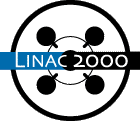
Z. LI, T. RAUBENHEIMER (SLAC)
One of the important aspects in the structure design for the JLC/NLC is to minimize the long-range dipole wakefield. The ways of suppressing the long-range wakefield are detuning and damping the dipole modes. While the detuning helps to reduce the wakefield in a short distance, the damping controls the wakefield at a longer distance from resurgence due to re-coherence among the modes. There are two primary damping schemes for traveling wave structures, namely the synchronous coupling scheme as used in the RDDS1 design and the local damping scheme as used in the CLIC structure design. In the local damping scheme, each cell is coupled to four radial wave-guides via coupling irises. Heavy damping for the dipole mode can be achieved with the proper design of the iris openings. On the other hand, the local damping scheme can have significant effects on the fundament mode as results of Q and shunt impedance reductions, which may lead to unwanted effects such as pulse heating and low in rf efficiency. In this paper, we will address some of the design issues on the locally damped structures at X-band. We will propose a medium damping approach as means of solving the rf efficiency and pulse heating problems. And we will discuss ideas on designing compact loads for the medium damped structures to minimize the excessive physical size associated with the local damping.
*Work supported by the Department of Energy, contract DE-AC03-76SF00515.
Comments or Questions to
linac2000@slac.stanford.edu